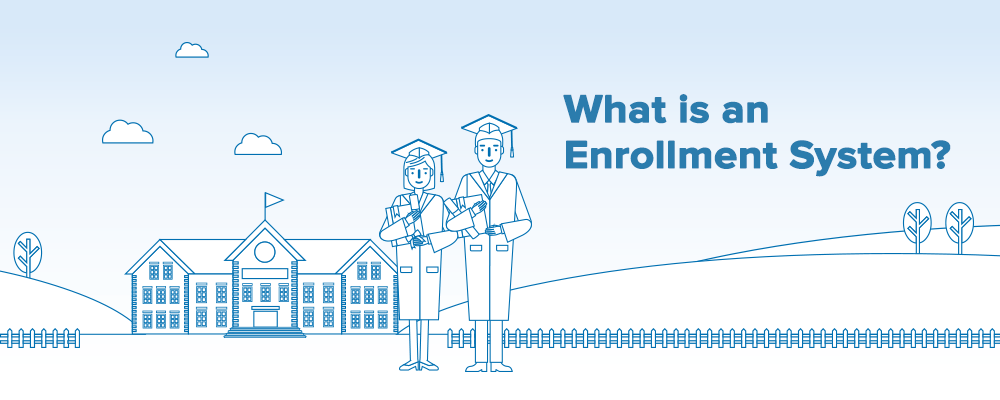
Learn how Asher College increased enrollments in less than 10 minutes! (Download the case study now!)
Several factors contribute to the success of a world class enrollment team. One of these key ingredients lies in how efficient and responsive they are. Applicants are not only looking for personalized attention at each step but also looking to get it quick. More than ever, relevant, valuable and timely information could be ample determinants in a prospect’s decision. And this ultimately links back to the enrollment system in place.
Enrollment systems, when implemented correctly, give admission teams a better leverage over student needs and motivations. The entire enrollment process, from contact to conversion, becomes seamless with a centralized system in place. Let’s take an organized look at some of the reasons why automated enrollment systems have become a priority when it comes to the student admissions and enrollment.
What is an Enrollment System?
One of the ripple effects of the stifling competition for education institutes is the growing necessity for schools to enhance their mechanisms for better serving applicant’s. This is where enrollment systems come into play, simplifying and accelerating student enrollment.
In simpler words, an enrollment system combines all activities involved in the entire enrollment process and integrates them into a system. This way, everything happens in one place, both online and offline. The conversation happened with the prospects, the pages they are visiting, their interests and motivations, their personal details, the meetings scheduled with them to name a few. The overall objective of an enrollment system is to help admission teams ultimately enroll more students.
Overview of the Enrollment Process
The enrollment process typically involves several stages, each crucial for ensuring a smooth transition from prospective student to enrolled student. These stages include:
- Prospective Student Inquiry and Application: The process begins when a prospective student expresses interest in the institution and submits an application.
- Admissions Review and Decision-Making: The admissions team reviews applications, evaluates candidates, and makes decisions on acceptance.
- Student Registration and Enrollment: Accepted students complete the registration process, selecting courses and finalizing their enrollment.
- Tuition Payment and Financial Aid Processing: Students arrange for tuition payments and apply for financial aid if needed.
- Student Data Management and Tracking: Throughout the process, student data is collected, managed, and tracked to ensure accurate records and facilitate future interactions.
Effective enrollment management is critical for educational institutions to attract and retain students, manage student data, and optimize resources. By streamlining these stages, institutions can provide a better experience for students and improve overall efficiency.
What Is the Difference Between Student Enrollment Management System and Education CRM?

It is really difficult to have a generic definition for an education CRM because it is used very differently across various higher education institutions. It is tuned to manage certain aspects of the enrollment process; therefore it is very difficult to define it. Let’s take the example of these aspects:
- Designing registration forms for events.
- Single registration/multi registration criteria
- Automatic invitations to the attendees
- Sending reminder emails
- Track cancellation of the event
- Track attendance of the event
- Send an email with a feedback form
- Mark students who are interested in the enrollment
You can see this is one of the many micro-processes happening in an institute. A CRM is fully capable of handling this whereas enrollment system or enrollment management system only deals with managing enrollment processes that are directly related to admission.
What Features Should You Look For in an Enrollment System?
As with all tech platforms, enrollment systems offer certain features that combine to get the job done, which is increasing enrollment efficiency in this case. It is these features that make the decision to adopt an effective solution for admissions a really smart one.
Admission teams often require this understanding when answering the seemingly tough question; what should I be looking out for when choosing an enrollment system for my school?
Additionally, integration with a student information system is crucial as it creates a unified platform that enhances efficiency by managing student data, admissions, and academic processes.
Inquiry management
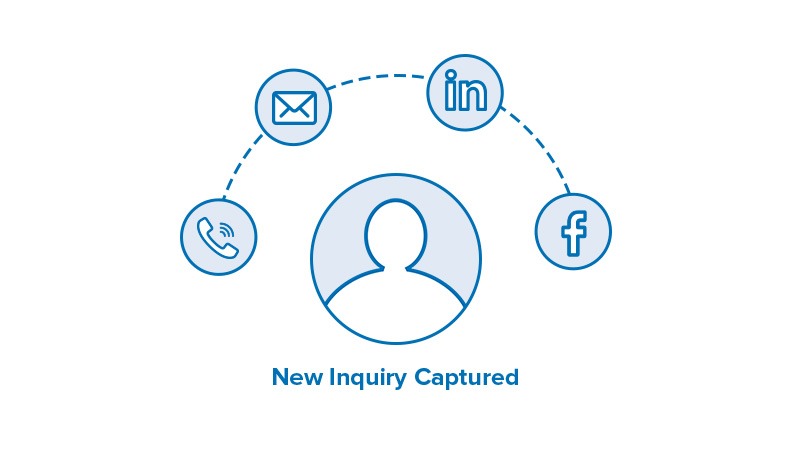
The student admissions process begins long before the applicant ever submits their first application. It starts when the prospects are weighing their options. As an admission officer, when a student asks to know more about your school, there is a very high chance that they are doing the same to several other schools.
To keep ahead of the competition, you need to serve them before they do. This is where an intuitive enrollment system gives you the edge – it stores all inquiries and communication about enrollment, automatically sends relevant information their way, and instantly notifies you about the inquiry. You can also distribute these leads to your team members based on location and expertise while keeping an overlooking eye on the entire admission process.
Automated follow-ups
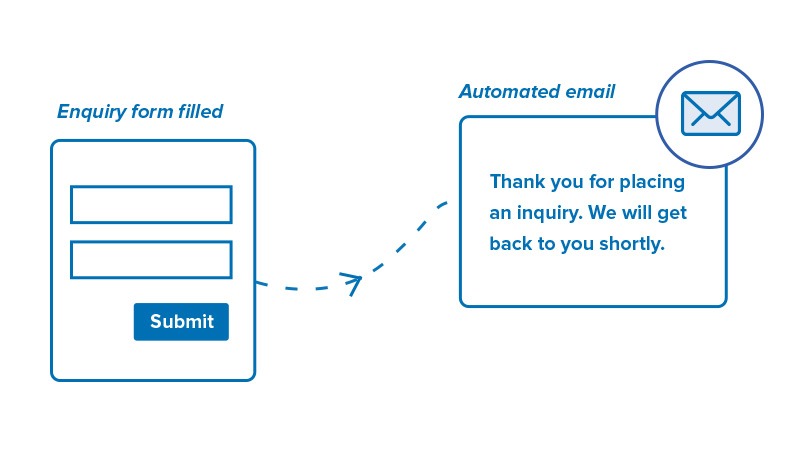
It is not possible to be available to answer a prospect’s query 24/7. Inquiries can come on a weekend also. What will happen after 6:00 pm in the evening, when your team is away? Automated follow-ups or autoresponders solve this problem. It is not a generic” Thank you for your interest. We will contact you later” message but it is intelligent enough to decide what an applicant wants by reading their behavior.
Your admission team can receive email and text notifications on their mobile phones every time an important, enrollment-centric action is performed. The system can be integrated with individual email accounts, where conversations with prospects can be easily monitored and actions can be taken viz-a-viz these conversations.
Setting parameters for lead prioritization
Another important feature is one that allows you to sort your prospects based on your ideal student persona. Enrollment system allows you to identify which applicants are the best fit for your institution by comparing in-system parameters like their age, location, course of interest, GPA/test results, etc. to a new inquiry. This way your admission team can chase the best inquiries first and filter out the junk ones, ensuring effective management throughout the student lifecycle.
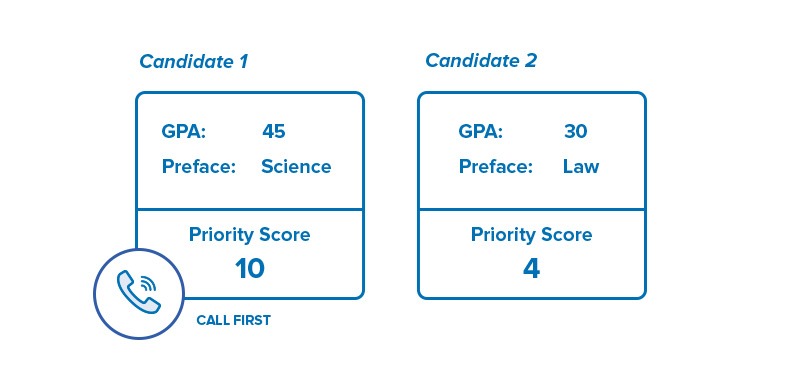
Communication and behavior tracking
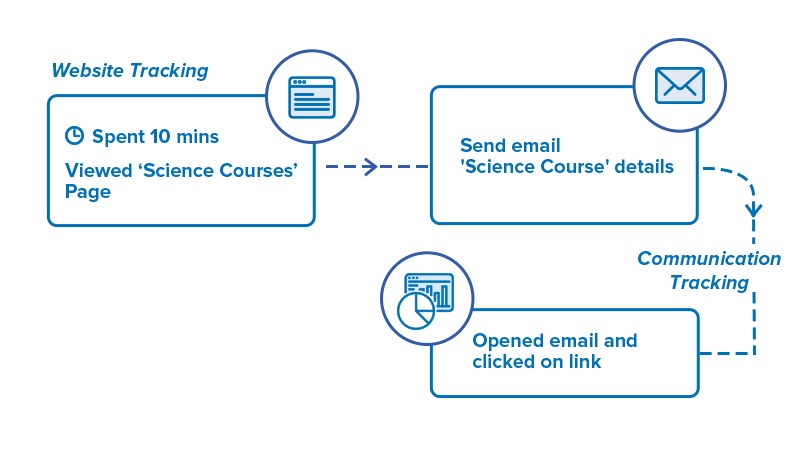
The student enrollment system stores all the communication and student behavior in one centralized view. Which means the admission rep has the visibility of all the necessary information about the prospect. Even when they follow up with the applicant they have clarity on what the applicant is up to and where did they leave him last time. This also makes sure that the admission team has the context to the conversation every time. Apart from that each activity your prospect does is given a score based on its importance. For example, email opened is given 2 points, and filling up a contact form is given 5 points. The cumulative score of an applicant is the reflection of how active they are on your website and other marketing channels.
Admissions process analytics
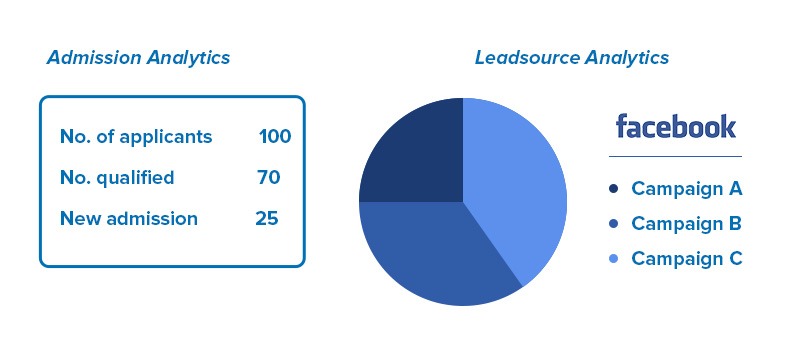
There’s only one way to know if you’re doing the right thing with your enrollment process. Data analysis. It spells everything out; the ratio of inquiries to applications; the best source of inquiry generation, the ratio of complete to incomplete applications; major locations where inquiries are coming from; and many more. The value that these insights bring cannot be overemphasized. Perhaps a read of the University of Oklahoma’s story of how it reached an enrollment record through analytics will be more convincing.
Task management
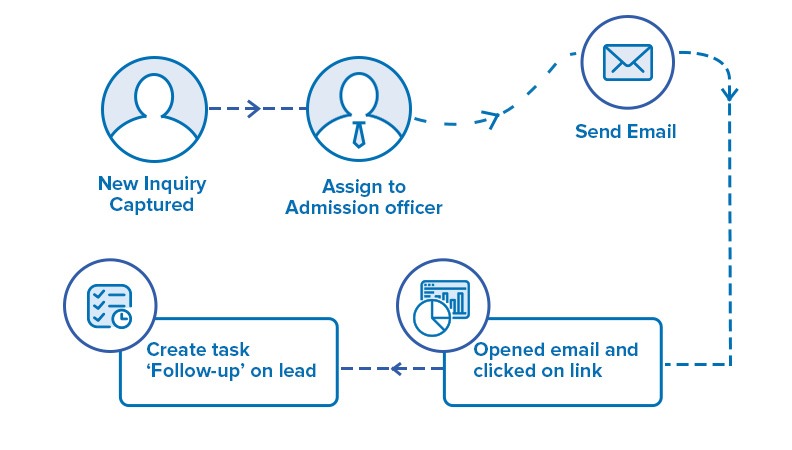
It is easy to lose track of activities when there’s no way of tracking them. An automated system simplifies the job of assigning tasks to members of an admissions team, as well as monitoring the execution, from counseling to spontaneous requests to attending scheduled meetings with applicants. A single lapse can lead to the drop-off of a prospect. This is why an enrollment system with a task management feature is important to student enrollment. The tasks could also be synced with mobile devices.
Here’s How Enrollment Systems Enhance The Entire Enrollment Process
In conversation with Maggie Zaman, Director of Admissions and Marketing at California Career Institute and Eddie Cook, Corporate Director of Admissions at Asher College–they shared how their enrollment systems helped them improve their admission processes –
Once we had our enrollment system in place, we analysed our interaction with students over the past 3 years. It helped us see the story behind every student, how we communicated about our courses or financial aid. It helped us enrich our enrollment process by making it more human
Maggie Zaman, Director of Admissions and Marketing
There is no beginning or end to a student journey cycle, we enroll students not to just to graduate but to be more employable. Leveraging techs like enrollment systems enables us to automate that first touch with student. This helps my admission reps to get more free time to engage with students they enrolled earlier to and aid them to navigate through the bumps and bruises of the course duration.
Eddie Cook, Corporate Director of Admissions
Check out the webinar recording here –
Integrating our enrollment system with a school management system further enhances our ability to manage student data, streamline operations, and improve overall user satisfaction.
Why Enrollment Systems Are Important
What makes an enrollment system so integral to the success of admission teams in higher education institutions? Why should institutions be doing everything they can to integrate their entire admission process? Here are some top reasons that give answers to these questions.
Ensure more applicants enter the enrollment process
One of the unwanted statistics in the higher education ecosystem is the shrinking in the pool of applicants. The aftermath of this is the stiff competition that now exists for students. Over in the UK for instance, applications to attend universities in the country have decreased by 11,000
This dip in applications hasn’t stopped the growing numbers of colleges. To harness the available, enrollment teams need to approach the admission process smartly. And this is where the importance of an automated enrollment system shines through. It is vital to enrollment management and so far, the colleges and universities doing better at enrolling students are those who have adopted smart application systems.
Attend to queries faster than ever before
Here’s a simple truth about student enrollment; the faster your responses to prospects’ requests, the higher your chances of engaging them. In today’s generation, no one wants to wait for ages for an admissions officer to attend to their inquiries when there’s another school out there waiting to attend to them. Because of the mobile nature of automated enrollment systems, admission officers can attend to inquiries on the go. You don’t always need a computer to get the job done.
With LeadSquared’s enrollment software, admissions teams can instantly respond to student inquiries, ensuring no prospect waits and every opportunity is captured in real-time.

Implementation and Integration
Implementing an enrollment system requires careful planning and integration with existing systems, such as student information systems, school management systems, and financial aid software. A well-executed implementation ensures that the new system works seamlessly with current processes and enhances overall efficiency.
- Planning for a Smooth Implementation-To ensure a smooth implementation, educational institutions should follow these steps:
- Define Clear Goals and Objectives- Establish what you aim to achieve with the enrollment system, such as improving response times or increasing enrollment rates.
- Assess Existing Systems and Processes-Evaluate current systems and identify areas that need improvement or integration.
- Choose a Suitable Enrollment Software Solution-Select an enrollment system that meets your institution’s specific needs and integrates well with existing systems.
- Develop a Comprehensive Implementation Plan- Create a detailed plan outlining the steps, timeline, and resources required for implementation.
- Provide Training and Support for Staff and Users- Ensure that all users are adequately trained and supported to use the new system effectively.
- Monitor and Evaluate the System’s Performance
Continuously assess the system’s performance and make necessary adjustments to optimize its functionality.
By following these steps, educational institutions can ensure a successful implementation of their enrollment system and improve their overall enrollment management processes. This not only enhances the efficiency of the admissions process but also provides a better experience for prospective students.
Climbing the Roadblocks
Adopting enrollment systems for student admissions may seem challenging and overwhelming for your admissions team. However, new-age enrollment systems are designed to be user-friendly and straightforward to implement, often featuring a plug-and-play model that simplifies the setup. With this in mind, admissions teams can approach the implementation of such software more confidently, knowing that these systems are meant to ease, not complicate, their tasks.
These enrollment systems empower schools to maximize their recruitment strategy by capturing every opportunity that arises. But to truly stay ahead of the competition—and maintain that advantage—it’s essential to choose the most suitable enrollment system for your unique admissions process. Explore how LeadSquared’s Enrollment Software can help you attract and enroll the right students seamlessly.








